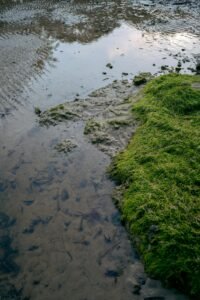
Have you ever wondered what lies beneath the shimmering surface of the ocean? In this captivating article, you will embark on a journey into the mesmerizing world of the sea. From the mysterious depths to the vastness of its horizon, “Ocean: A Review” unveils a myriad of wonders waiting to be discovered. Prepare to be amazed as we explore the enchanting ecosystems, magnificent creatures, and breathtaking phenomena that make the ocean an awe-inspiring treasure trove of beauty and mystery. Get ready to dive into an oceanic adventure like no other!

Physical Characteristics
Size
The ocean is vast and covers about 71% of the Earth’s surface, making it the largest habitat on our planet. It spans over 139 million square miles and is divided into five major basins: the Pacific Ocean, the Atlantic Ocean, the Indian Ocean, the Southern Ocean, and the Arctic Ocean. These basins are further divided into smaller segments such as the North Atlantic Ocean or the Mediterranean Sea.
Depth
The ocean is not only wide but also incredibly deep. Its average depth is about 12,080 feet (3,682 meters). Some areas, such as the Mariana Trench in the Pacific Ocean, go even deeper reaching a staggering depth of 36,070 feet (10,994 meters). The ocean’s depth is home to a myriad of unique species and fascinating geological formations.
Temperature
The temperature of the ocean varies depending on various factors such as location, depth, and season. In general, surface temperatures range from around 28°C (82°F) in the tropical regions to near freezing temperatures in polar regions. As you go deeper into the ocean, the temperature decreases. In the deeper zones, like the abyssopelagic zone, temperatures can drop to near freezing or even below.
Salinity
Salinity refers to the amount of salt dissolved in ocean water. On average, the ocean has a salinity of about 3.5%, which means that for every 1,000 grams of water, 35 grams are salt. The salinity levels can vary slightly depending on factors like evaporation and precipitation. Areas with high evaporation rates, such as the Red Sea, often have higher salinity levels, while regions with high rainfall, like the Baltic Sea, have lower salinity.
Ocean Zones
Epipelagic Zone
The epipelagic zone, also known as the sunlight zone or the ocean surface, is the topmost layer of the ocean that receives ample sunlight. This zone extends from the ocean’s surface down to about 650 feet (200 meters) deep. It is where most photosynthesis occurs, supporting a diverse range of marine life such as phytoplankton, zooplankton, and fish.
Mesopelagic Zone
The mesopelagic zone, also called the twilight zone, lies beneath the epipelagic zone and extends between 650 and 3,280 feet (200 to 1,000 meters) deep. In this zone, sunlight is scarce, and many organisms have developed unique adaptations to survive in low light conditions. Here, you can find a variety of bioluminescent species like lanternfish, hatchetfish, and deep-sea squid.
Bathypelagic Zone
The bathypelagic zone, also known as the midnight zone, is the layer of the ocean that extends from 3,280 to 13,123 feet (1,000 to 4,000 meters) deep. In this zone, complete darkness prevails, and the water pressure is immense. Despite these extreme conditions, this zone is inhabited by remarkable creatures like viperfish, anglerfish, and giant squid.
Abyssopelagic Zone
The abyssopelagic zone, also called the abyssal zone, begins around 13,123 feet (4,000 meters) deep and continues down to approximately 19,686 feet (6,000 meters). This zone is characterized by extremely high pressure, low temperatures, and a lack of light. Remarkably, even in these extreme conditions, fascinating organisms can be found, such as deep-sea anemones, bristle worms, and sea spiders.
Hadopelagic Zone
The hadopelagic zone, also known as the trenches, represents the deepest parts of the ocean. Diving down to around 20,000 feet (6,000 meters) or deeper, these trenches are the ultimate frontier for exploration. The pressure in this zone is crushing, and only a few specialized organisms, such as deep-sea amphipods and unique types of bacteria, have been discovered to survive here.

Currents
Surface Currents
Surface currents are the horizontal movements of water occurring at or near the ocean’s surface. They are mainly driven by winds, the Earth’s rotation, and temperature differences. Some well-known surface currents include the Gulf Stream, which transports warm water from the Gulf of Mexico to the North Atlantic, and the Kuroshio Current, which flows along the east coast of Japan. These currents play a vital role in redistributing heat and nutrients, influencing climate patterns, as well as facilitating the migration of marine species.
Deep Water Currents
Deep water currents, also known as thermohaline currents or ocean conveyor belt, are the vertical movements of water occurring in the deeper layers of the ocean. These currents are driven by differences in water density, caused by variations in temperature and salinity. They move enormous amounts of water globally, playing a crucial role in transporting heat, distributing nutrients, and impacting climate systems on a massive scale. One notable deep water current is the North Atlantic Deep Water, which forms near Greenland and flows southward.
Upwelling and Downwelling
Upwelling and downwelling are vertical movements of water that occur in specific areas of the ocean. Upwelling happens when deep, nutrient-rich water rises to the surface, bringing essential nutrients for marine life. These areas are often highly productive and support an abundance of fish and other organisms. Downwelling, on the other hand, occurs when surface water sinks and moves towards deeper layers. Downwelling areas can transport oxygen and other dissolved gases, impacting oceanic ecosystems.
Coral Reefs
Importance of Coral Reefs
Coral reefs are among the most diverse and productive ecosystems on Earth, providing habitats for numerous marine species. They serve as nurseries for fish, protect coastlines from storms and erosion, and support tourism and recreation industries. Coral reefs also play a vital role in global carbon cycling by sequestering carbon dioxide. Additionally, they provide countless cultural and aesthetic values, contributing to the well-being of coastal communities worldwide.
Threats to Coral Reefs
Coral reefs face numerous threats, primarily due to human activities. Climate change, including rising sea temperatures and ocean acidification, poses a significant risk to coral health. Pollution, overfishing, destructive fishing practices, and physical damage caused by tourism and development also contribute to reef degradation. Invasive species and coral diseases further exacerbate the decline of coral reefs globally.
Conservation Efforts
To protect and conserve coral reefs, various initiatives and strategies have been implemented worldwide. These range from the establishment of marine protected areas to the promotion of sustainable fishing practices. Efforts also focus on reducing pollution, including the management of wastewater and runoff, as well as raising awareness about the importance of coral reefs and their fragile ecosystem. Collaboration between governments, scientists, local communities, and conservation organizations is essential for the success of these conservation efforts.

Marine Life
Biodiversity
The ocean is teeming with an incredible diversity of marine life. From microscopic plankton to massive whales, it is home to an estimated one million known species, with many more yet to be discovered. The ocean’s biodiversity is essential for ecological stability, as different species play crucial roles in nutrient cycling, carbon sequestration, and maintaining the balance of marine ecosystems.
Whales and Dolphins
Whales and dolphins are some of the most captivating creatures in the ocean. With their remarkable intelligence and social behavior, they have captured the fascination of humans for centuries. From the massive blue whale, the largest animal to ever exist, to the acrobatic dolphins, these marine mammals have unique adaptations that allow them to thrive in diverse oceanic environments.
Reef Fish
Reef fish, such as clownfish, parrotfish, and butterflyfish, are an integral part of coral reef ecosystems. They contribute to the overall biodiversity and health of the reef by playing vital roles in food chains, nutrient cycling, and maintaining the balance of reef communities. These colorful and diverse fish species attract snorkelers and divers worldwide, showcasing the beauty of coral reef habitats.
Sharks
Sharks are often misunderstood and vilified due to their portrayal in popular media. However, they play a crucial role in maintaining the balance of ocean ecosystems as apex predators. As keystone species, sharks help regulate fish populations, prevent the spread of disease, and contribute to overall ecosystem resilience. Protecting sharks and promoting sustainable fishing practices is key to ensuring the health and stability of marine ecosystems.
Marine Mammals
Marine mammals, including seals, sea lions, and manatees, are well-adapted to life in the ocean. These charismatic creatures are highly adapted to their marine environment, with streamlined bodies, flippers or limbs modified for swimming, and specialized respiratory systems. Marine mammals fulfill various ecological roles, from controlling prey populations to transferring nutrients between different ocean zones.
Ocean Pollution
Types of Ocean Pollution
Ocean pollution encompasses a wide range of contaminants that end up in the marine environment. It includes plastic waste, oil spills, chemical contaminants, and excess nutrients from agricultural runoff. Trash such as plastic bottles, bags, and fishing nets pose a severe threat to marine life, while oil spills can have long-lasting ecological consequences on entire ecosystems. Chemical pollutants, like heavy metals and pesticides, can accumulate in organisms, causing harm to their health and affecting the food chain.
Sources of Pollution
The sources of ocean pollution are diverse and include industrial discharges, improper waste management, agricultural runoff, and the improper disposal of plastics and other non-biodegradable materials. Pollution can also originate from offshore oil and gas exploration, shipping activities, and urban development in coastal areas. Addressing these pollution sources requires collaborative efforts between governments, industries, and individuals to implement stricter regulations, promote sustainable practices, and adopt cleaner technologies.
Impact on Marine Life
Ocean pollution has significant impacts on marine life. Plastic waste entangles and suffocates marine animals, disrupting their natural behaviors and causing injury or death. Chemical pollutants can accumulate in the tissues of organisms, leading to reproductive issues, developmental abnormalities, and even extinction. Oil spills coat marine animals and their habitats, impairing their ability to swim, fly, or breathe, and contaminating their food sources. Additionally, excess nutrients from agricultural runoff can result in harmful algal blooms, depleting oxygen levels, and leading to dead zones devoid of marine life.
Prevention and Solutions
Preventing and reducing ocean pollution requires a multifaceted approach. It starts with individuals adopting more sustainable lifestyles, reducing single-use plastic consumption, properly disposing of waste, and supporting recycling initiatives. Governments need to enforce stricter regulations on industrial and agricultural practices, encourage the use of eco-friendly alternatives, and incentivize industries to adopt cleaner technologies. Collaboration between nations, NGOs, and scientists is crucial to monitor and analyze pollution levels, develop innovative solutions, and raise awareness about the importance of protecting our oceans.
Ocean Exploration
Historical Expeditions
Throughout history, numerous expeditions have ventured into the ocean, pushing the boundaries of human exploration. One of the most famous expeditions was that of Jacques Cousteau, who pioneered scuba diving and underwater filming, bringing the wonders of the ocean to millions. Other notable explorers include James Cook, who documented vast portions of the Pacific Ocean, and Charles Darwin, whose voyage aboard the HMS Beagle revolutionized our understanding of marine biodiversity.
Modern Exploration Techniques
Modern ocean exploration relies on advanced technologies to reach greater depths and uncover the mysteries of the deep. Remotely Operated Vehicles (ROVs) and Autonomous Underwater Vehicles (AUVs) allow scientists to explore and collect data from extreme environments like deep-sea hydrothermal vents and uncharted areas. Sonar systems enable detailed mapping of the ocean floor, revealing intricate underwater landscapes. Satellites provide valuable data on ocean currents, temperature, and the extent of sea ice, enhancing our understanding of climate systems.
Discoveries and Contributions
Ocean exploration has led to numerous groundbreaking discoveries and contributed invaluable knowledge to various scientific disciplines. From mapping previously unexplored regions of the ocean floor to discovering new species and understanding marine ecosystems, these findings have provided a deeper understanding of our planet and its interconnectedness. Ocean exploration has also contributed to the development of technologies such as underwater cameras, submersibles, and deep-sea sampling techniques, which have applications beyond the realms of marine science.
Ocean Conservation
Protected Marine Areas
To safeguard sensitive ecosystems and vulnerable species, protected marine areas have been established worldwide. These areas, such as marine sanctuaries, marine parks, and marine reserves, provide a haven for marine life by restricting harmful activities such as fishing, mining, and drilling. These protected areas serve as essential ecological refuges, allowing populations to recover and maintaining the overall health of marine ecosystems. Expanding the coverage of protected marine areas and improving their management is crucial for the long-term conservation of our oceans.
Sustainable Fishing Practices
Addressing overfishing and promoting sustainable fishing practices is paramount to maintaining healthy fish populations and preserving marine ecosystems. Sustainable fishing practices include implementing fishing quotas, protecting breeding and spawning grounds, using selective fishing gear, and promoting sustainable aquaculture practices. Collaboration between governments, fishing industries, scientists, and consumers is essential to ensure sustainable fishing practices are adopted and enforced globally.
Reducing Plastic Waste
Plastic waste poses a significant threat to the health of the oceans and marine life. To mitigate this problem, reducing plastic waste at its source is crucial. Governments should implement policies that promote the use of eco-friendly alternatives, encourage recycling, and discourage single-use plastics. Individuals can contribute by practicing responsible waste management, reducing plastic consumption, and supporting efforts to clean up and recycle plastic waste. As a global society, we must work together to eliminate plastic pollution and protect our oceans for future generations.
Famous Shipwrecks
Titanic
The sinking of the RMS Titanic in 1912 is one of the most famous shipwrecks in history. The tragic event led to the loss of more than 1,500 lives and became a symbol of maritime disaster. Located deep in the North Atlantic Ocean, the wreckage of the Titanic was rediscovered in 1985, and subsequent expeditions have shed light on the events surrounding its sinking. The Titanic serves as a reminder of the vulnerability of large maritime vessels and the importance of safety regulations at sea.
Lusitania
The sinking of the RMS Lusitania in 1915 during World War I remains a significant historical event. The British ocean liner was struck by a German torpedo off the coast of Ireland, resulting in the loss of around 1,200 lives. The sinking of the Lusitania played a role in shaping public opinion and hastening the United States’ entry into the war. The wreckage serves as a memorial to those who perished and a reminder of the tragedies of war.
Bismarck
The sinking of the German battleship Bismarck during World War II marked a significant turning point in naval warfare. In 1941, the Bismarck, one of the largest battleships ever built, was engaged in a naval battle with British forces in the Atlantic Ocean. After sustaining heavy damage, it ultimately sank, resulting in the loss of nearly 2,000 lives. The discovery of the wreck in 1989 provided valuable insights into the design and fate of this legendary warship.
Andrea Doria
The sinking of the Italian luxury liner SS Andrea Doria in 1956 is another notable shipwreck. The Andrea Doria collided with the Swedish ship MS Stockholm off the coast of Nantucket, Massachusetts, leading to the loss of 46 lives. Despite the tragedy, the successful rescue of the majority of passengers and crew became one of the most remarkable maritime salvage operations in history.
HMS Victory
The HMS Victory was a renowned British naval ship that served in many famous battles, including the Battle of Trafalgar in 1805. However, it sank in a storm in 1744 off the coast of the Channel Islands. The wreck was discovered in 2008 and remains an important archaeological site and a tribute to this iconic warship.
Conclusion
The ocean is a remarkable and vital part of our planet. Its physical characteristics, from its vast size and depth to its varying temperature and salinity, create diverse habitats that support countless forms of life. The different ocean zones, currents, and unique ecosystems like coral reefs contribute to the rich biodiversity found within the marine realm.
However, the ocean faces numerous challenges. Coral reefs are threatened by climate change and human activities, while pollution, overfishing, and habitat destruction put marine life at risk. It is crucial that we prioritize ocean conservation, implement sustainable practices, and protect vulnerable species and habitats. By valuing and preserving the ocean, we can ensure its health and sustainability for generations to come. So let’s join hands and become stewards of the sea, working together to safeguard this awe-inspiring and valuable natural treasure.





